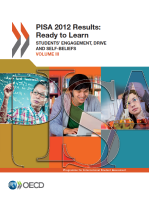PISA 2012 Results: Ready to Learn: Students' Engagement, Drive and Self-Beliefs (Volume III)
|
This report is the third in a series of volumes presenting the results of PISA 2012. It explores students’ engagement with and at school, their drive and motivation to succeed, and the beliefs they hold about themselves as mathematics learners. PISA 2012 assessed the competencies of 15-year-olds in reading, mathematics and science (with a focus on mathematics) in 65 countries and economies. Around 510 000 students between the ages of 15 years 3 months and 16 years 2 months participated in the assessment, representing about 28 million 15-year-olds globally.
|
|
Contents
|
||
Chapter 1 |
What it takes to learn |
|
|
This chapter introduces the concepts of student engagement, drive and self-belief, without which students are unable to make the most of learning opportunities in school and won’t be ready to translate their potential into high-level skills. The chapter discusses the economic and social dynamics shaping the need to prepare students for lifelong learning and describes the structure of the volume. |
||
Chapter 2 |
Engagement with and at school |
|
|
This chapter examines several indicators of student engagement: arriving late for school, skipping days of school or classes, feeling a sense of belonging at school, and holding positive attitudes towards school. The chapter explores how these dispositions are associated with performance in mathematics, whether and how they are related to gender and socio-economic status, and how they have evolved among students since 2003. |
||
Chapter 3 |
Students’ drive and motivation |
|
|
This chapter explores several indicators related to students’ drive and motivation: perseverance, openness to problem solving, perceived control over success in mathematics and in school, perceived self-responsibility for failing in mathematics and intrinsic and instrumental motivation to learn mathematics. The chapter discusses how these dispositions are associated with performance in mathematics, whether and how they are related to gender and socio-economic status, and how they have evolved among students since 2003. |
||
Chapter 4 |
Mathematics self-beliefs and participation in mathematics-related activities |
|
|
This chapter examines several ways in which students’ beliefs in their own mathematics skills manifest themselves: self-efficacy (the extent to which students believe in their own ability to solve specific mathematics tasks), self-concept (students’ beliefs in their own mathematics abilities), anxiety (feelings of helplessness and stress when dealing with mathematics), student engagement in mathematics activities at and outside school, and students’ intentions to pursue mathematics-related studies or careers in the future. These are analysed in relation to mathematics performance, gender and socio-economic status. Trends in students’ mathematics self-beliefs since 2003 are also examined. |
||
Chapter 5 |
The role of teachers and schools in shaping students’ engagement, drive and mathematics self-beliefs |
|
|
This chapter discusses how students’ engagement with and at school, their drive and their self-beliefs are influenced by policies and practices at school. Exposure to mathematics problems at school, teachers’ practices, teacher-student relations, and disciplinary climate in the classroom are discussed in relation to students’ dispositions towards learning. The chapter also analyses the effect on these dispositions when students compare their performance to that of other students in the same school, and examines trends in the relationship between students’ engagement, motivation and self-belief and the schools they attend. > Download Excel tables part 1 |
||
Chapter 6 |
The role of families in shaping students’ engagement, drive and mathematics self-beliefs |
|
|
This chapter explores the different ways in which home environment can contribute to students’ engagement with and at school, their levels of drive and motivation and their beliefs about themselves as mathematics learners. It examines parents’ influence as active participants in their child’s education, both at home and at school, as role models, and as their child’s best champions in the expectations they hold for their child’s future. The association between the home environment and mathematics performance is also discussed. |
||
Chapter 7 |
Gender and socio-economic disparities in students' engagement, drive and mathematics self-beliefs |
|
|
This chapter examines the link between students’ dispositions towards learning mathematics and gender and socio-economic disparities in mathematics performance. It focuses particularly on these differences among students who show similar performance and among the highest-performing students. |
||
Chapter 8 |
Policy implications of students’ dispositions towards learning |
|
|
PISA results show that drive, motivation and confidence in oneself are essential if students are to fulfil their potential; but too many students lack some of these dispositions towards learning that would enable them to flourish. This chapter considers how the education policies of school systems and individual schools are associated with students’ engagement with school, their drive and their self-beliefs. |
||
Annexes |
Technical Background |
|
Annex A |
Annex A1 Construction of mathematics scales and indices from the student, school and parent context questionnaires Annex A3 Technical notes on analyses in this volume Annex A4 Quality assurance Annex A5 Technical details of trends analyses Annex A6 Anchoring Vignettes in the PISA 2012 Student Questionnaire |
|
Annex B |
PISA 2012 DataAnnex B1 Results for countries and economies |
|
> Back to PISA 2012 Results for Volumes I, II, IV
Related Documents



